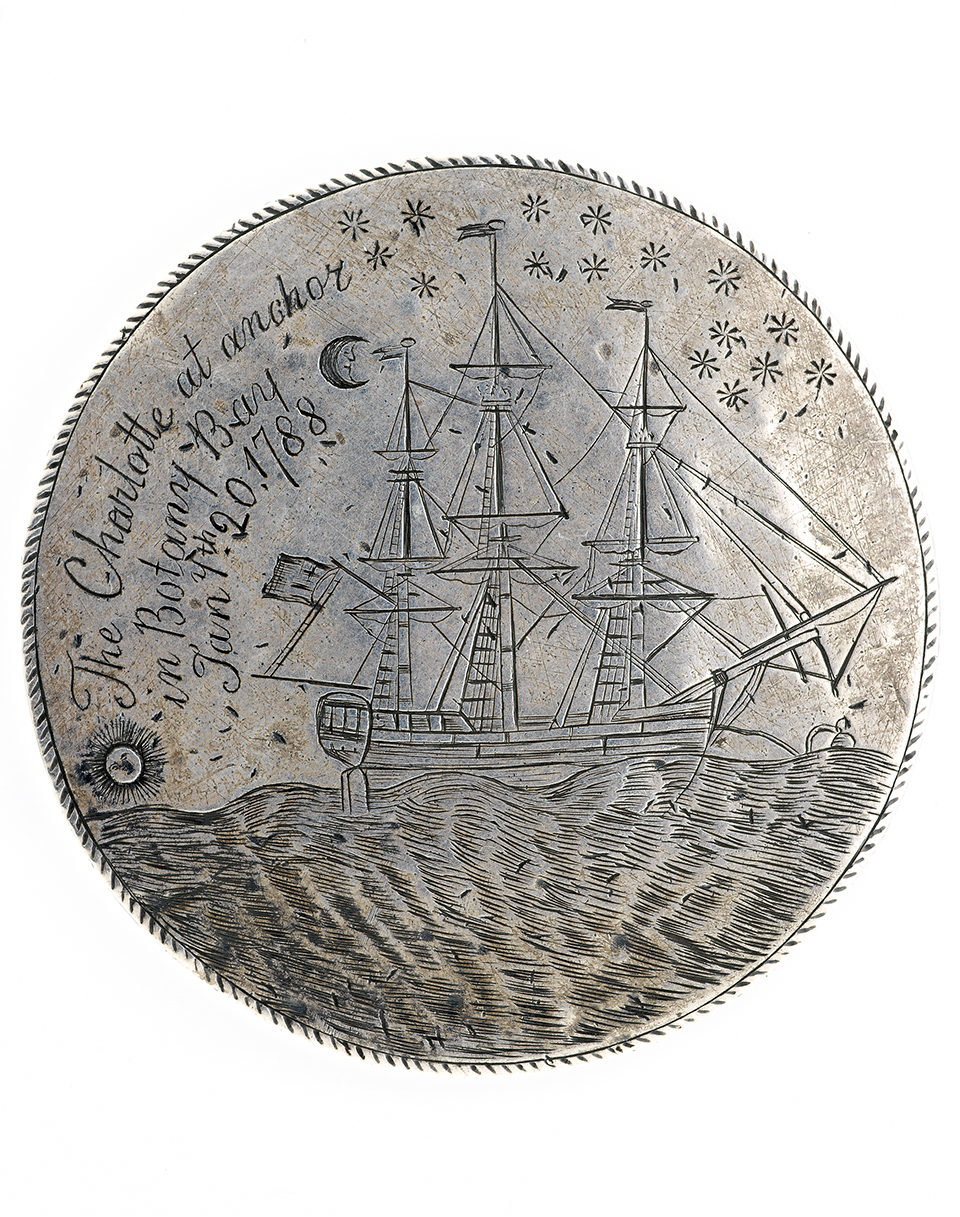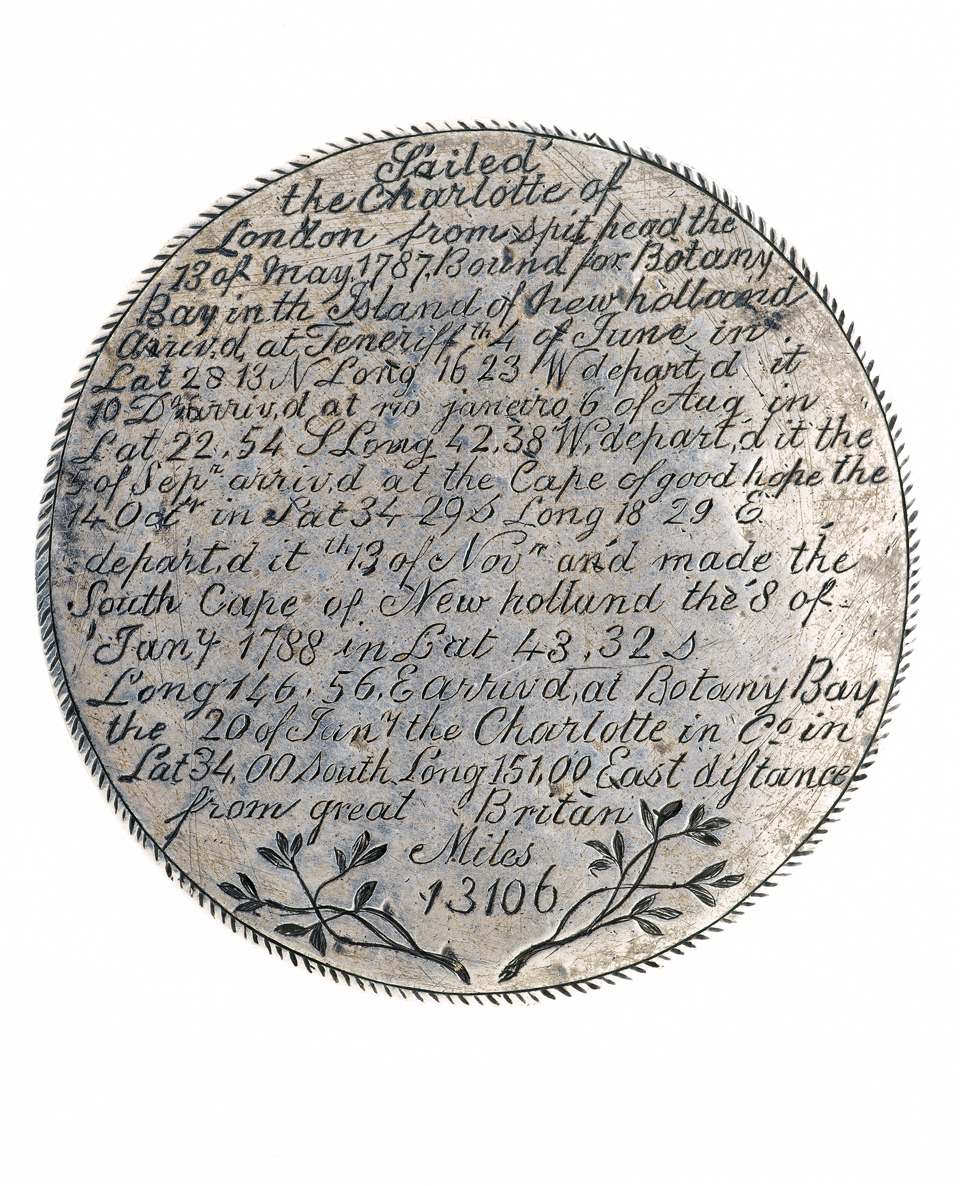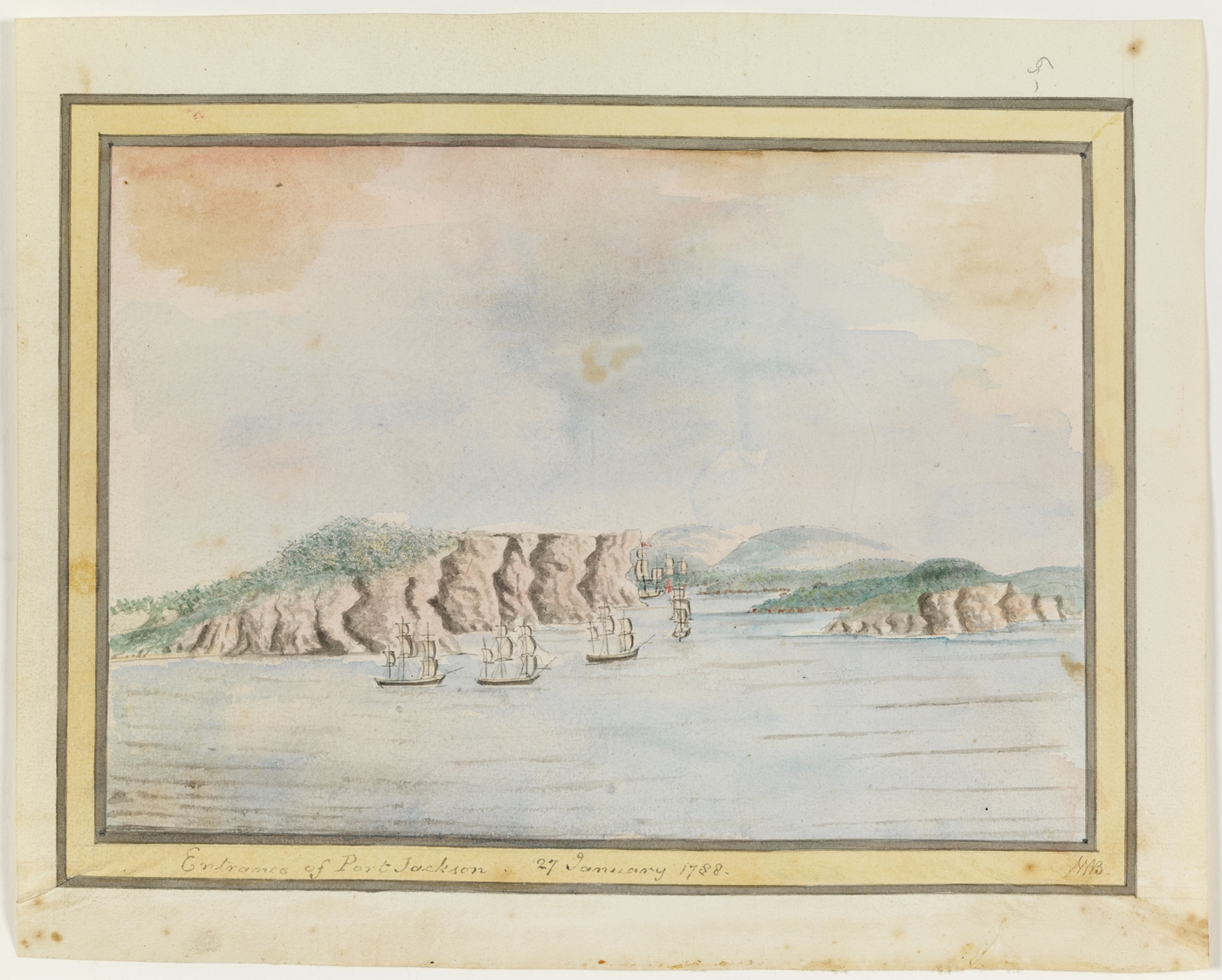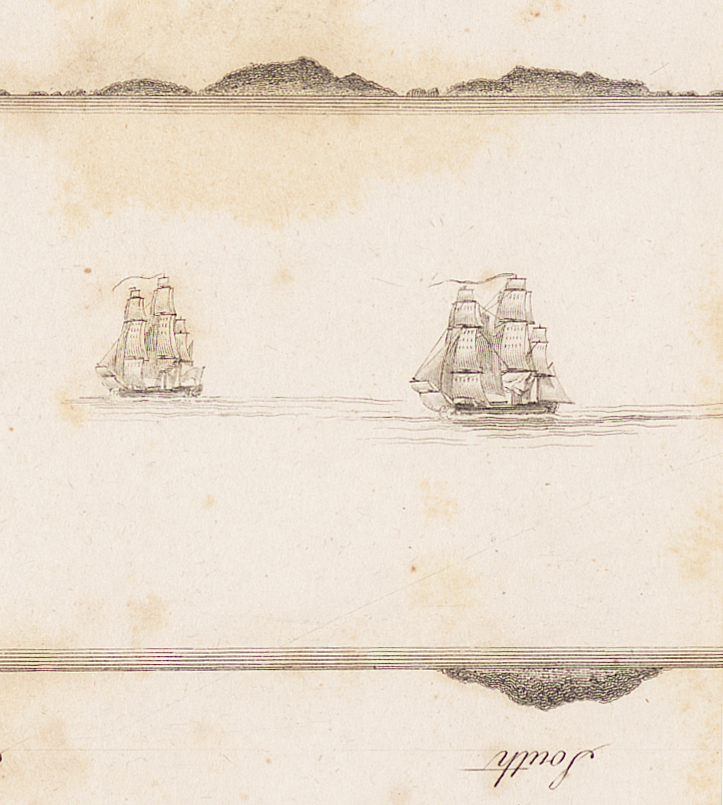The Dictionary of Sydney was archived in 2021.
Charlotte
Citation
Persistent URL for this entry
To cite this entry in text
To cite this entry in a Wikipedia footnote citation
To cite this entry as a Wikipedia External link
Charlotte
[media]The Charlotte was one of six transports among the 11 ships known collectively as the First Fleet, which sailed from Portsmouth, England to establish a penal colony at Botany Bay in the late 1780s under the command of Captain Arthur Phillip. Male and female convicts, convicts' children, crew, and marines and their families were aboard the Charlotte.
Built in 1784 on the River Thames, Charlotte was a two-decked, three-masted barque that weighed 345 tons, measured 105 feet (32 metres) in length, 28 feet (8.5 metres) in breadth, six feet and six inches (1.98 metres) between decks and carried six guns. Charlotte was named after the wife of the ship’s merchant owner, William Matthews, who was the London agent of Matthew Boulton. Originally a merchant vessel, Charlotte only became part of the First Fleet when the Royal Admiralty leased the ship in November 1786 as a late replacement for the Britannia, which was found to be unsuitable for the voyage. [1]
Convict passengers
Charlotte received her prisoners from the Dunkirk prison hulk lying in the Hamoaze, Plymouth, during a break in extremely inclement weather on 12 March 1787. [2] As a heavy sailor, Charlotte then had to be towed by boats into Plymouth Sound and reached the other transports and supply ships on the Mother Bank at Spithead on 17 March 1787. [3] According to the ship's surgeon John White, the male convicts had all been immediately constrained in irons upon being transferred from the Dunkirk to the Charlotte [4] and remained in them until 20 May 1787.
The precise number of male and female convicts aboard Charlotte is difficult to establish, owing to transfers between the transport ships both before departure and during the voyage, as well as a number of deaths at sea. However, between 92 and 94 male convicts and 29 female convicts are recorded as spending time on the Charlotte throughout the journey. Ages ranged between 17 and 61 with the majority aged in their twenties. Most had sentences for seven years' transportation, but there were also six life sentences, eight for 14 years and one five-year sentence.
[media]Among the Charlotte's prisoners were two female convicts and 19 male convicts who had been involved in the mutiny on the Mercury in 1784. Three of those male mutineers also participated in the mutiny on the Swift in 1783. Other convicts of note transported on the Charlotte were James Squire, James Bloodsworth, Samuel Lightfoot, William Bryant and Mary Bryant, James Martin, [5] and Thomas Barrett. Barrett was commissioned by surgeon White to engrave the Charlotte Medal to commemorate the ship's journey, but [media]Barrett also had the dubious honour of being the first person executed in Australia on 27 February 1788 after being found guilty of stealing beef and peas. [6]
A total of four convicts died on the Charlotte en route. Mercury mutineer 26-year-old William Brown fell overboard in the South Atlantic. The others were 44-year-old Edward Chanin, [7] 26-year-old John Clark, [8] and the 'tolerably decent and orderly' 32-year-old Ishmael Coleman who, according to surgeon White, 'worn out by lowness of spirits and debility, brought on by long and close confinement', [9] succumbed to illness 15 days into the 252-day voyage.
Free passengers and crew
The Charlotte's master was Captain Thomas Gilbert. Also on board were Captain-Lieutenant Watkin Tench, Lieutenant John Cresswell, Lieutenant John Poulden, [10] forty-two marines and their families, approximately 30 crew, surgeon White's servant William Broughton, and a total of six convicts' children. Three of the children were born in England and embarked as 'free' passengers with their convicted parents. Another three children were born to convicts at sea, although one of these three died during the voyage and the other two survived the journey only to die in early infancy.
Transport arrival and commercial departure
[media]The Charlotte arrived on 19 January 1788 at Botany Bay, which was promptly deemed ill suited for settlement. Subsequently, Charlotte entered the superior site for the settlement, Port Jackson, with the rest of the fleet on 26 January 1788.
[media]On 6 and 8 May 1788 respectively, the Scarborough and Charlotte left Sydney Cove bound for Canton, China to collect a cargo of tea under contract to the East India Company and to conduct private trade. [11] Upon returning to England in June 1789, Charlotte was sold to Walbrook merchants Bond & Co for the London-Jamaica route. Charlotte was sold twice more, lastly to a merchant in Quebec in 1810.
Despite remaining in the Lloyd’s Register until 1823, Charlotte was lost off Newfoundland in November 1818. [12]
References
Causer, Tim, ed. Memorandums of James Martin. London: The Bentham Project, UCL, 2014, http://www.ucl.ac.uk/Bentham-Project/publications/martins-memorandoms/martins-memorandoms.html
Redding, Cyrus. Personal Reminiscences of Eminent Men, Volume 3. London: Saunders, Otley & Co, 1867.
Tench, Watkin. A Narrative of the Expedition to Botany Bay. London, New York: J Debrett, re-printed by T and J Swords, 1789.
White, John. Journal of a Voyage to New South Wales: With Sixty-Five Plates of Non Descript Animals, Birds, Lizards, Serpents, Curious Cones of Trees and Other Natural Productions. London: J Debrett, 1790.
Notes
[1] Dirk HR Spennemann, 'The British Merchant Vessel Charlotte' (1788), Digital Micronesia website, http://marshall.csu.edu.au/Marshalls/html/MIShips/Charlotte.html, viewed 28 December 2014
[2] John White, Journal of a Voyage to New South Wales: With Sixty-Five Plates of Non Descript Animals, Birds, Lizards, Serpents, Curious Cones of Trees and Other Natural Productions (London: J. Debrett, 1790) online at http://gutenberg.net.au/ebooks03/0301531h.html, viewed 31 December 2014
[3] Charlotte needed to be towed again on 13 May 1787 by the Hyaena frigate. John White, Journal of a Voyage to New South Wales, (1790) online at http://gutenberg.net.au/ebooks03/0301531h.html viewed 31 December 2014
[4] John White, Journal of a Voyage to New South Wales: With Sixty-Five Plates of Non Descript Animals, Birds, Lizards, Serpents, Curious Cones of Trees and Other Natural Productions (London: J. Debrett, 1790) online at http://gutenberg.net.au/ebooks03/0301531h.html, viewed 31 December 2014
[5] James Martin wrote the only extant first-hand account by a First Fleet convict, Tim Causer, ed, Memorandums of James Martin, (London: The Bentham Project, UCL, 2014), online at http://www.ucl.ac.uk/Bentham-Project/publications/martins-memorandoms/martins-memorandoms.html, viewed 28 December 2014
[6] 'Charlotte', First Fleet Fellowship website, http://firstfleetfellowship.org.au/ships/hms-charlotte/, viewed 28 December 2014
[7] Cause of death unknown.
[8] Cause of death unknown.
[9] John White, Journal of a Voyage to New South Wales: With Sixty-Five Plates of Non Descript Animals, Birds, Lizards, Serpents, Curious Cones of Trees and Other Natural Productions (London: J. Debrett, 1790) online at http://gutenberg.net.au/ebooks03/0301531h.html, viewed 31 December 2014
[10] 'Convict Ship Charlotte 1788', Free Settler or Felon website, http://www.jenwilletts.com/convict_ship_charlotte_1788.htm, viewed 28 December 2014
[11] 'Charlotte', First Fleet Fellowship website, http://firstfleetfellowship.org.au/ships/hms-charlotte/, viewed 28 December 2014
[12] Dirk HR Spennemann, 'The British Merchant Vessel Charlotte' (1788), Digital Micronesia website, http://marshall.csu.edu.au/Marshalls/html/MIShips/Charlotte.html, viewed 28 December 2014
.







